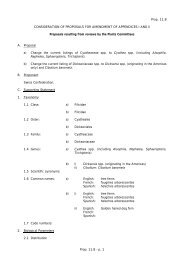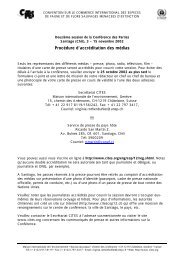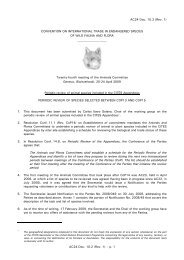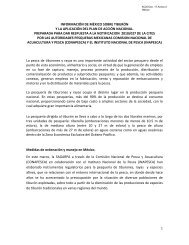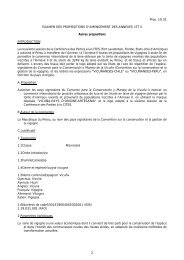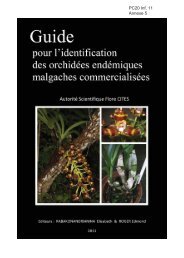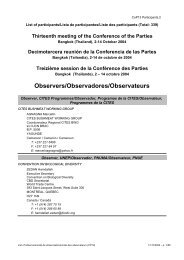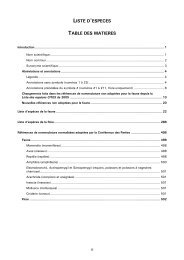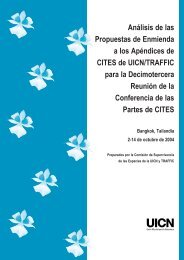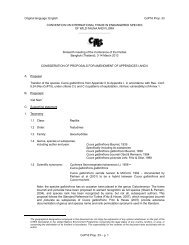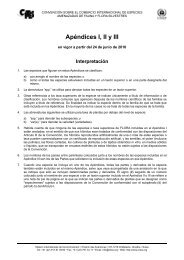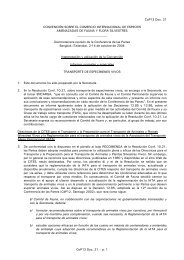Lamna nasus - Cites
Lamna nasus - Cites
Lamna nasus - Cites
You also want an ePaper? Increase the reach of your titles
YUMPU automatically turns print PDFs into web optimized ePapers that Google loves.
Draft Proposal to list <strong>Lamna</strong> <strong>nasus</strong> in Appendix II - prepared by Germany in January 2012<br />
baseline. (ICCAT SCRS/ICES 2009; Figures 10 and 11.) During this period, total landings from the Northeast<br />
Atlantic declined to 13% of their 1930s levels.<br />
<strong>Lamna</strong> <strong>nasus</strong> has been fished by many European countries, principally Denmark, France, Norway, Faroes and<br />
Spain (Figures 5–9). Norway’s target L. <strong>nasus</strong> longline fishery began in the 1920s and first peaked at 3,884t in<br />
1933. About 6,000t were landed in 1947, when the fishery reopened after the Second World War, followed by<br />
a decline to between 1,200–1,900t from 1953–1960. The collapse of this fishery led to the redirection of<br />
fishing effort by Norwegian, Faroese and Danish longline shark fishing vessels into the Northwest Atlantic<br />
(see below). Norwegian landings from the Northeast Atlantic subsequently decreased to a mean for the past<br />
decade of 20t, 99.99% during a range of time series (135 to 56<br />
years). FAO Fishstat (2009) records very small landings since the 1970s by Malta, in recent years also Spain.<br />
In the North Tyrrhenian and Ligurian Sea, Serena and Vacchi (1997) reported only 15 specimens of L. <strong>nasus</strong><br />
during a few decades of observation. Soldo and Jardas (2002) reported only nine records in the Eastern<br />
Adriatic from the end of 19 th century until 2000. Since then there have been only a few new records (A. Soldo<br />
unpublished data). Newborn and juvenile L. <strong>nasus</strong> have been reported in the Western Ligurian and central<br />
Adriatic Seas (Orsi Relini and Garibaldi 2002, Marconi and De Maddalena 2001). No L. <strong>nasus</strong> were caught<br />
during research into western Mediterranean swordfish longline fishery bycatch (De La Serna et al. 2002).<br />
Only 15 specimens were caught during research conducted in 1998–1999 on bycatch in large pelagic fisheries<br />
(mainly driftnets) in the southern Adriatic and Ionian Sea (Megalofonou et al. 2000).<br />
Northwest Atlantic<br />
Detailed stock assessments and recovery projections are available (DFO 2005; Gibson and Campana 2005;<br />
Campana and Gibson 2008; ICCAT SCRS/ICES 2009; Campana et al. 2010b). Spawning stock biomass<br />
(SSB) is currently estimated to be about 22–27% of its size in 1961. The estimated number of mature females<br />
in 2009 is in the range of 11,000 to 14,000 individuals, or 12% to 16% of its 1961 level and just 6% of the<br />
total population (ICCAT/ICES 2009; Campana et al. 2010b).<br />
Targeted <strong>Lamna</strong> <strong>nasus</strong> fishing started in 1961, when Norwegian and subsequently Faeroese shark longline<br />
fleets moved from the depleted Northeast Atlantic to the coast of New England and Newfoundland. Catches<br />
increased rapidly from ~1,900t in 1961 to > 9,000t in 1964 (Figure 12). By 1965 many vessels had switched to<br />
other species or fishing grounds because of the population decline (DFO 2001a). The fishery collapsed after six<br />
years, landing less than 1,000t in 1970. It took 25 years for only very limited recovery to take place. Norwegian<br />
and Faroese fleets have been excluded from Canadian waters since 1993. Canadian and US authorities<br />
reported all landings after 1995.<br />
Three offshore and several inshore Canadian vessels entered the targeted Northwest Atlantic fishery in the<br />
1990s. Catches of 1,000–2,000 t/year reduced population levels to a new low in under ten years: the average<br />
size of sharks and catch rates were the smallest on record in 1999 and 2000, catch rates of mature sharks in<br />
2000 were 10% of those in 1992, and biomass estimated as 11–17% of virgin biomass and fully recruited F as<br />
0.26 (DFO 2001a). The annual catch quota was reduced for 2002–2007 to allow population growth (DFO<br />
Page 6 of 14<br />
AC26 Doc. 26.2, Annex 1 – p. 6<br />
AC26 Doc. 26.2<br />
Annex / Anexo /Annexe<br />
(English only / únicamente en inglés / seulement en anglais)




